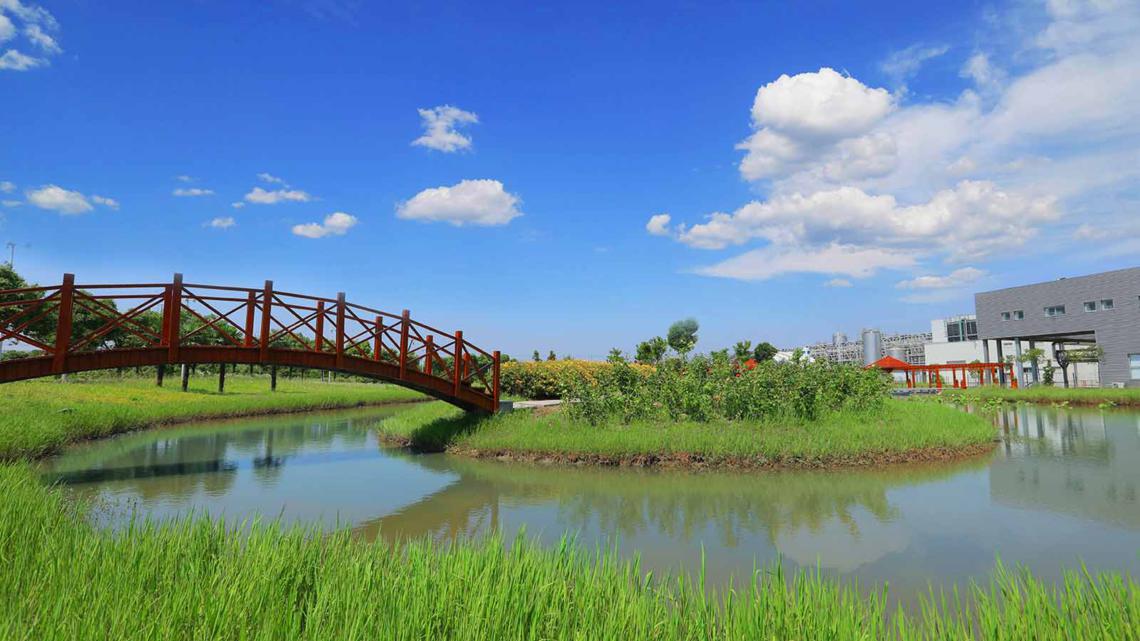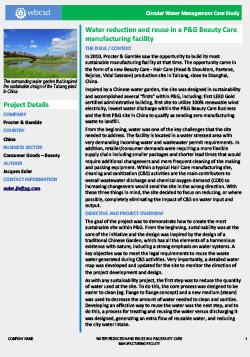The issue / context
In 2010, Procter & Gamble saw the opportunity to build its most sustainable manufacturing facility at that time. The opportunity came in the form of a new Beauty Care - Hair Care (Head & Shoulders, Pantene, Rejoice, Vidal Sassoon) production site in Taicang, close to Shanghai, China.
Inspired by a Chinese water garden, the site was designed in sustainability and accomplished several “firsts” within P&G, including: first LEED Gold certified administrative building, first site to utilize 100% renewable wind electricity, lowest water discharge within the P&G Beauty Care Business and the first P&G site in China to qualify as sending zero manufacturing waste to landfill.
From the beginning, water was one of the key challenges that the site needed to address. The facility is located in a water stressed area with very demanding incoming water and wastewater permit requirements. In addition, retailer/consumer demands were requiring a more flexible supply chain including smaller packages and shorter lead times that would require additional changeovers and more frequent cleaning of the making and packing equipment. Within a typical Hair Care manufacturing site, cleaning and sanitization (C&S) activities are the main contributors to overall wastewater discharge and chemical oxygen demand (COD) so increasing changeovers would send the site in the wrong direction. With these three things in mind, the site decided to focus on reducing, or where possible, completely eliminating the impact of C&S on water input and output.
Objective and project overview
The goal of the project was to demonstrate how to create the most sustainable site within P&G. From the beginning, sustainability was at the core of the initiative and the design was inspired by the design of a traditional Chinese Garden, which has all the elements of a harmonious existence with nature, including a strong emphasis on water systems. A key objective was to meet the legal requirements to reuse the wastewater generated during C&S activities. Very importantly, a detailed water map was developed and updated for the site to monitor the direction of the project development and design.
As with any sustainability project, the first step was to reduce the quantity of water used at the site. To do this, the core process was designed to be easier to clean (eg. flange to flange concept) and a new medium (steam) was used to decrease the amount of water needed to clean and sanitize. Developing an effective way to reuse the water was the next step, and to do this, a process for treating and reusing the water versus discharging it was designed, generating an extra flow of reusable water, and reducing the city water intake.
The specific solutions were to treat washwater by dissolved air flotation (DAF), in biological tanks, by filtration and by reverse osmosis (RO) filtration. The wastewater RO permeate was then sent directly to utilities (mainly cooling towers) and to the core process, while the wastewater RO concentrate went into a mechanical vapor recompression evaporator to create condensate that was then used to run on-site utility systems. A storage tank was used to balance the water streams. In order to ensure the water sent to core process is on par with the incoming city water, the site used active carbon filters and chlorine addition. The percentage reached for this flow is around 12%, with a qualification in place to reach 25%1.
There were several challenges that presented themselves during the development of this project. It was difficult to develop a sustainability scope parallel to the core process development. Ensuring adequate water reuse with a new team and local chemicals was also an issue, as well as the increase in treatment costs as the water became more concentrated. Having firm go/no-go success criteria helped define the business need and these issues were addressed by the stakeholders involved in the project and fixed within the first year.
The business case
It was essential for the site to not only comply with the strict legal requirements, but to also ensure the longevity of operations in a water-stressed area. The team wanted to develop a best in class approach to be good water stewards, effectively operate within stringent permit requirements and exceed P&G sustainability and water reduction targets. While doing so, the project also delivered savings, mainly from reduction on:
- Cost of purified water;
- Cost of heating water and purchasing steam;
- Cost of C&S water treatment;
- Cost of concentrated water disposal (via trucks).
Decision making process
From day one, sustainability was part of the site’s equity, referred to as “a factory inspired by a garden.” The Vice President of manufacturing was a key advocate of this vision and clear conservation targets for the overall design allowed R&D, Engineering, and Manufacturing to “design in” sustainability as part of the go/no-go success criteria.
Changes could be made within the facility, as well as within the equipment/process design which made it more economically affordable (versus trying to add a sustainability dimension to an already designed unit). However, this required many iterations, as there were often missing pieces of information until the final scope was reached. Therefore, ensuring adequate cross-functional support (including sustainability) on decision-making proved to be critical at each step of the project, from pre-feasibility to start-up.
The engineering team optimized the process and developed a new model for the site’s wastewater plant, while the Quality and Health, Safety & Environment (HS&E) teams ensured no compromise for their respective program. The project was, and continues to be, managed by the local project team in China and supported by the Global Beauty Sustainability Organization. Experienced vendors were involved to help achieve the project goals.
Project details & finances
- The project was optimized from a cost standpoint. The core process work was justified on a cost savings basis and the C&S water treatment was justified based on compliance to local permit requirements.
- A valuation study was done by the Beauty Care sustainability group leading to a proposal at the beginning of the project that included the overall cost estimates and success criteria. The cost of water at the various stages of the process, from buying water to wastewater treatment was calculated and used in the financial justification for the project.
- The equipment enabling water reuse was considered as development work to assess the potential to reuse water in utilities and reduce the dependence on discharge volumes. This was necessary due to the strict code in place due to the site’s proximity to Lake Tai. The cost of the reuse equipment was more affordable thanks to the overall C&S water volume reduction.
- Information about the local community and status of water availability in the area were shared with leadership and considered while developing the project objectives.
Project results
Today, the site is the company benchmark for water reuse, and beneficially reuses most of the C&S water. This was achieved first by optimization of C&S in the core process, and the reuse of 60% of the treated water back into the cooling towers, and 12% into the core process while maintaining the quality and safety requirements to allow for a very flexible operation. Versus a baseline from similar sites, this facility uses 40,000m3/year less water through core process optimization and an additional 20,000m3/year reduction through reuse for a total of 60,000m3 in annual water savings.
Lessons learned
Some key lessons learned have been:
- Importance of a strong vision/business case along with clear leadership support.
- Need to understand the local basin in order to develop a sustainable manufacturing site for the long term
- Importance of an integrated approach with the project team to accomplish the objectives and address issues (multi-functional team – R&D, Engineering, QA, Manufacturing, etc.)
- Essential to start with sustainability as a core aspect of the design and not wait until the end to add it onto the criteria - otherwise it is not affordable (design in sustainability from the beginning)
- Importance of creating a detailed water map to drive the right decision and design
- Based off our learnings from this initial pilot site, on the next project the wastewater plant will be designed directly for water reuse versus adding post treatment. In this way, the process could be improved even further.
Future implementation and next steps
The C&S and water filtration/reuse processes developed at this site are now being benchmarked and reapplied for Beauty Care process optimization. The site is implementing additional measures to reach 95% water reuse by the end of 2017.
This case study forms part of the WBCSD Business Guide to Circular Water Management (2017), available for download here.
Download case study
Project detailsCompany: Procter & Gamble Country: China Business sector: Consumer Goods - Beauty Author(s): Jacques Euler Contact information: euler.jh@pg.com |


